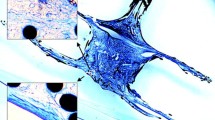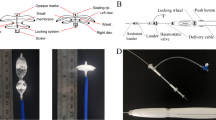Abstract
Reproducibility of clinical output is important when investigating therapeutic efficacy in pre-clinical animal studies. Due to its physiological relevance, a swine myocardial infarction (MI) model has been widely used to evaluate the effectiveness of stem cells or tissue-engineered constructs for ischemic heart diseases. Several methods are used to induce MI in the swine model. However, it is difficult, using these approaches, to obtain a similar level of functional outcomes from a group of animals due to interpersonal variation, leading to increased experimental cost. Hence, in order to minimize human intervention, we developed an approach to use a customized occluder that has dimensional similarities with that of the coronary artery of animals in the case of the swine model. We carried out angiography to measure the diameter of the middle left anterior descending artery of each individual animal to fabricate the customized occluder using a 3D-printing system. The fabricated occluder contained a central hole smaller than that of the targeted middle left anterior descending artery to mimic an atherosclerotic coronary artery that has an approximately 20% blocked condition. Interestingly, the 3D-printed occluder can provide continuous blood flow through the central pore, indicating a high survival rate (88%) of up to 28 days post-operation. This method showed the possibility of creating consistent myocardial infarction induction as compared to the conventional representative closed-chest method (50% survival rate), thus highlighting how our method can have a profound effect on accelerating reliable experiments for developing new therapeutic approaches to ischemic heart diseases.
Graphic abstract







Similar content being viewed by others
References
Sanchis-Gomar F, Perez-Quilis C et al (2016) Epidemiology of coronary heart disease and acute coronary syndrome. Ann Transl Med 4(13):7. https://doi.org/10.21037/atm.2016.06.33
Mozaffarian D, Benjamin EJ, Go AS et al (2016) Heart disease and stroke statistics—2016 update. Circulation 133(4):e38–e360. https://doi.org/10.1161/CIR.0000000000000350
Rodrigues M, Silva A, Aguas A et al (2020) The coronary circulation of the pig heart: comparison with the human heart. Eur J of Anat 9(2):67–87
Sun S, Guo T (2009) Model establishment of acute myocardium infarction induced by coronary occlusion versus balloon occlusion in miniature pigs. J Clin Rehabil Tissue Eng Res 13:9913–9916. https://doi.org/10.3969/j.issn.1673-8225.2009.50.023
Tang YP, Liu Y, Fan YJ et al (2018) To develop a novel animal model of myocardial infarction: a research imperative. AMEM 1(1):36–39. https://doi.org/10.1002/ame2.12010
Krombach GA, Kinzel S, Mahnken AH et al (2005) Minimally invasive close-chest method for creating reperfused or occlusive myocardial infarction in swine. Invest Radiol 40(1):14–18
Biondi-Zoccai G, De Falco E, Peruzzi M et al (2013) A novel closed-chest porcine model of chronic ischemic heart failure suitable for experimental research in cardiovascular disease. Biomed Res Int. https://doi.org/10.1155/2013/410631
Bergey JL, Nocella K, McCallum JD (1982) Acute coronary artery occlusion-reperfusion-induced arrhythmias in rats, dogs and pigs: antiarrhythmic evaluation of quinidine, procainamide and lidocaine. Eur J Pharmacol 81(2):205–216. https://doi.org/10.1016/0014-2999(82)90438-1
Hawk C, Leary S, Morris T (2005) American college of laboratory animal medicine, european college of laboratory animal medicine. Formulary for laboratory animals, 3rd edn. Blackwell Pub, Ames, Iowa
Ye L, Chang YH, Xiong Q et al (2014) Cardiac repair in a porcine model of acute myocardial infarction with human induced pluripotent stem cell-derived cardiovascular cells. Cell Stem Cell 15(6):750–761. https://doi.org/10.1016/j.stem.2014.11.009
Munz MR, Faria MA, Monteiro JR et al (2011) Surgical porcine myocardial infarction model through permanent coronary occlusion. Comp Med 61(5):445–452
Jang J, Park HJ, Kim SW et al (2017) 3D printed complex tissue construct using stem cell-laden decellularized extracellular matrix bioinks for cardiac repair. Biomaterials 112:264–274. https://doi.org/10.1016/j.biomaterials.2016.10.026
Kim BS, Das S, Jang J et al (2020) Decellularized extracellular matrix-based bioinks for engineering tissue- and organ-specific microenvironments. Chem Rev 120(19):10608–10661. https://doi.org/10.1021/acs.chemrev.9b00808
Schiller NB, Shah PM, Crawford M et al (1989) Recommendations for quantitation of the left ventricle by two-dimensional echocardiography. J Am Soc Echocardiogr 2(5):358–367. https://doi.org/10.1016/S0894-7317(89)80014-8
Eckert AW, Schutze A, Lautner MH et al (2010) HIF-1alpha is a prognostic marker in oral squamous cell carcinomas. Int J Biol Markers 25(2):87–92. https://doi.org/10.1089/hyb.2009.0115.MAb
Colbert LE, Fisher SB, Balci S et al (2015) High nuclear hypoxia-inducible factor 1 alpha expression is a predictor of distant recurrence in patients with resected pancreatic adenocarcinoma. Int J Radiat Oncol Biol Phys 91(3):631–639. https://doi.org/10.1016/j.ijrobp.2014.11.004
Stavrou S, Gratz M, Tremmel E et al (2018) TAAR1 induces a disturbed GSK3β phosphorylation in recurrent miscarriages through the ODC. Endocr Connect 7(2):372–384. https://doi.org/10.1530/ec-17-0272
Hosenpud JD, Yung N, Morton MJ (1983) Left ventricular pressure-volume relations shift to the left after long-term loss of pericardial restraint. Circulation 68(1):155–163. https://doi.org/10.1161/01.CIR.68.1.155
Reffelmann T, Sensebat O, Birnbaum Y et al (2004) A novel minimal-invasive model of chronic myocardial infarction in swine. Coron Artery Dis 15(1):7–12. https://doi.org/10.1097/00019501-200402000-00002
Fröhlich GM, Meier P, White SK et al (2013) Myocardial reperfusion injury: looking beyond primary PCI. Eur Heart J 34(23):1714–1722. https://doi.org/10.1093/eurheartj/eht090
Schwartz LM, Lagranha CJ (2006) Ischemic postconditioning during reperfusion activates Akt and ERK without protecting against lethal myocardial ischemia-reperfusion injury in pigs. AM J Physiol-Heart C 290(3):H1011–H1018. https://doi.org/10.1152/ajpheart.00864.2005
Rissanen TT, Nurro J, Halonen PJ et al (2013) The bottleneck stent model for chronic myocardial ischemia and heart failure in pigs. Am J Physiol-Heart C 305(9):H1297–H1308. https://doi.org/10.1152/ajpheart.00561.2013
Radke PW, Heinl-Green A, Frass OM et al (2006) Evaluation of the porcine ameroid constrictor model of myocardial ischemia for therapeutic angiogenesis studies. Endothelium 13(1):25–33. https://doi.org/10.1080/10623320600660128
Bose S, Vahabzadeh S, Bandyopadhyay A (2013) Bone tissue engineering using 3D printing. Mater Today 16(12):496–504. https://doi.org/10.1016/j.mattod.2013.11.017
Park SA, Lee SJ, Lim KS et al (2015) In vivo evaluation and characterization of a bio-absorbable drug-coated stent fabricated using a 3D-printing system. Mater Lett 141:355–358. https://doi.org/10.1016/j.matlet.2014.11.119
Morrison RJ, Kashlan KN, Flanangan CL et al (2015) Regulatory considerations in the design and manufacturing of implantable 3D-printed medical devices. Clin Transl Sci 8(5):594–600. https://doi.org/10.1111/cts.12315
Kim HK, Jeong MH, Ahn Y et al (2017) Relationship between time to treatment and mortality among patients undergoing primary percutaneous coronary intervention according to Korea acute myocardial infarction registry. J Cardiol 69(1):377–382. https://doi.org/10.1016/j.jjcc.2016.09.002
Nair LS, Laurencin CT (2007) Biodegradable polymers as biomaterials. Prog Polym 32(8–9):762–798. https://doi.org/10.1016/j.progpolymsci.2007.05.017
Berne RM (1963) Cardiac nucleotides in hypoxia: possible role in regulation of coronary blood flow. Am J Physiol Content 204(2):317–322. https://doi.org/10.1152/ajplegacy.1963.204.2.317
Reimer KA, Lowe JE, Rasmussen MM et al (1977) The wavefront phenomenon of ischemic cell death. 1. Myocardial infarct size vs duration of coronary occlusion in dogs. Circulation 56(5):786–794. https://doi.org/10.1161/01.CIR.56.5.786
Lee SH, Wolf PL, Escudero R et al (2000) Early expression of angiogenesis factors in acute myocardial ischemia and infarction. N Engl J Med 342(9):626–633. https://doi.org/10.1056/NEJM200003023420904
Tekin D, Dursun AD, Xi L (2010) Hypoxia inducible factor 1 (HIF-1) and cardioprotection. Acta Pharmacol Sin 31(9):1085–1094. https://doi.org/10.1038/aps.2010.132
Acknowledgements
This research was supported by the Bio & Medical Technology Development Program and Basic Science Research Program through the National Research Foundation (NRF), funded by the Korean government (MSIT) (No. 2018M3A9E2024584) and the Ministry of Trade, Industry and Energy (MOTIE) and Korea Institute for Advancement of Technology (KIAT) through the International Cooperative R&D program (No. P0011282).
Author information
Authors and Affiliations
Contributions
HBK, HP, DSS, MK, YA, MHJ, and YJH conducted all animal experiments and analyzed experimental results. SJ and JJ developed and fabricated a 3D-printed occluder and analyzed experimental results. HBK and SJ were involved in writing-original draft and visualization. SD was involved in writing-review and editing. JJ and YJH were involved in conceptualization, writing-original draft, review and editing, and contributed to supervision and funding acquisition.
Corresponding authors
Ethics declarations
Conflict of interest
The authors declare that there is no conflict of interest.
Ethical approval
All institutional and national guidelines for the care and use of laboratory animals were followed.
Supplementary Information
Below is the link to the electronic supplementary material.
Rights and permissions
About this article
Cite this article
Kim, H.B., Jung, S., Park, H. et al. Customized 3D-printed occluders enabling the reproduction of consistent and stable heart failure in swine models. Bio-des. Manuf. 4, 833–841 (2021). https://doi.org/10.1007/s42242-021-00145-4
Received:
Accepted:
Published:
Issue Date:
DOI: https://doi.org/10.1007/s42242-021-00145-4




